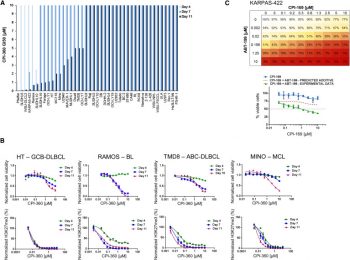
| Size | Price | Stock | Qty |
|---|---|---|---|
| 1mg |
|
||
| 5mg |
|
||
| 10mg |
|
||
| 25mg |
|
||
| 50mg |
|
||
| 100mg |
|
||
| 250mg | |||
| 500mg | |||
| Other Sizes |
Purity: ≥98%
CPI-169 (CPI169) is a novel, potent, and selective inhibitor of EZH2 (enhancer of zeste homolog 2) inhibitor with anticancer activity. It inhibits EZH2 WT, EZH2 Y641N, and EZH1 with IC50s of 0.24 nM, 0.51 nM, and 6.1 nM, respectively. CPI-169 exhibits excellent antiproliferative activity and high in vivo antitumor efficacy in a NHL xenograft model.
| ln Vitro |
|
||
|---|---|---|---|
| ln Vivo |
|
||
| Animal Protocol |
|
||
| References |
Chem Biol.2014 Nov 20;21(11):1463-75.
|
||
| Additional Infomation |
1-[1-(1-ethylsulfonyl-4-piperidinyl)ethyl]-N-[(4-methoxy-6-methyl-2-oxo-1H-pyridin-3-yl)methyl]-2-methyl-3-indolecarboxamide is an indolecarboxamide.
|
| Molecular Formula |
C27H36N4O5S
|
|
|---|---|---|
| Molecular Weight |
528.66
|
|
| Exact Mass |
528.24
|
|
| CAS # |
1450655-76-1
|
|
| Related CAS # |
|
|
| PubChem CID |
78357814
|
|
| Appearance |
Typically exists as solid at room temperature
|
|
| Density |
1.3±0.1 g/cm3
|
|
| Index of Refraction |
1.631
|
|
| LogP |
2.67
|
|
| Hydrogen Bond Donor Count |
2
|
|
| Hydrogen Bond Acceptor Count |
6
|
|
| Rotatable Bond Count |
8
|
|
| Heavy Atom Count |
37
|
|
| Complexity |
1040
|
|
| Defined Atom Stereocenter Count |
0
|
|
| SMILES |
O=C(C1=C(C)N(C(C2CCN(S(=O)(CC)=O)CC2)C)C3=C1C=CC=C3)NCC4=C(OC)C=C(C)NC4=O
|
|
| InChi Key |
LHGUZCKPFXXVPV-UHFFFAOYSA-N
|
|
| InChi Code |
InChI=1S/C27H36N4O5S/c1-6-37(34,35)30-13-11-20(12-14-30)18(3)31-19(4)25(21-9-7-8-10-23(21)31)27(33)28-16-22-24(36-5)15-17(2)29-26(22)32/h7-10,15,18,20H,6,11-14,16H2,1-5H3,(H,28,33)(H,29,32)
|
|
| Chemical Name |
1-[1-(1-ethylsulfonylpiperidin-4-yl)ethyl]-N-[(4-methoxy-6-methyl-2-oxo-1H-pyridin-3-yl)methyl]-2-methylindole-3-carboxamide
|
|
| Synonyms |
|
|
| HS Tariff Code |
2934.99.9001
|
|
| Storage |
Powder -20°C 3 years 4°C 2 years In solvent -80°C 6 months -20°C 1 month |
|
| Shipping Condition |
Room temperature (This product is stable at ambient temperature for a few days during ordinary shipping and time spent in Customs)
|
| Solubility (In Vitro) |
|
|||
|---|---|---|---|---|
| Solubility (In Vivo) |
|
| Preparing Stock Solutions | 1 mg | 5 mg | 10 mg | |
| 1 mM | 1.8916 mL | 9.4579 mL | 18.9157 mL | |
| 5 mM | 0.3783 mL | 1.8916 mL | 3.7831 mL | |
| 10 mM | 0.1892 mL | 0.9458 mL | 1.8916 mL |
*Note: Please select an appropriate solvent for the preparation of stock solution based on your experiment needs. For most products, DMSO can be used for preparing stock solutions (e.g. 5 mM, 10 mM, or 20 mM concentration); some products with high aqueous solubility may be dissolved in water directly. Solubility information is available at the above Solubility Data section. Once the stock solution is prepared, aliquot it to routine usage volumes and store at -20°C or -80°C. Avoid repeated freeze and thaw cycles.
Calculation results
Working concentration: mg/mL;
Method for preparing DMSO stock solution: mg drug pre-dissolved in μL DMSO (stock solution concentration mg/mL). Please contact us first if the concentration exceeds the DMSO solubility of the batch of drug.
Method for preparing in vivo formulation::Take μL DMSO stock solution, next add μL PEG300, mix and clarify, next addμL Tween 80, mix and clarify, next add μL ddH2O,mix and clarify.
(1) Please be sure that the solution is clear before the addition of next solvent. Dissolution methods like vortex, ultrasound or warming and heat may be used to aid dissolving.
(2) Be sure to add the solvent(s) in order.
 |
|---|